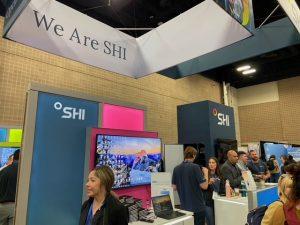TCEA 2023: The surprising ways the conversation in education has shifted:
Tomorrow’s classroom is fresh yet familiar.

With the Covid-19 crisis being increasingly contained, our state of emergency is almost over. Consequently, the state of our schools is looking almost familiar. Academic institutions everywhere are reassessing their staffing, reallocating their funding, and re-evaluating their teaching. These actions reveal a clear intention: Get back to reality. But that doesn’t mean virtual reality is being put out to pasture.
At the Texas Computer Education Association (TCEA) Convention in early February, educators and administrators declared their priorities around education technology, set to last long after 2023. SHI was onsite to keep you posted on all the conversation surrounding edtech innovations.
Rigor returns
Drinking fountains aren’t the only thing schools are reactivating post-peak pandemic: Academic rigor is next. In the panic to restructure during the pandemic, a nagging leniency developed that’s proven tough to shake. Unfortunately, the data reflects its troubling results. But once again, students’ accountability ratings are an important measure, including the overall end of year ratings assigned to schools. Highly rated K-12 schools are desperate to stay that way, while those that perform lower are at high risk of staff turnover and seeking additional support. As has always been the case, the state itself gets more involved the worse the school’s situation becomes.
One thing is also certain: Any improved test scores are going to be hard-earned. Academic integrity is back in full force with some exciting technology at its back, thwarting any essays that are copied from a friend or constructed by AI. Ultimately, there’s a renewed emphasis on accountability that encompasses educators and students alike.
While the concepts of rigor and intensity may seem like unwavering staples in any academic system, since the onset of pandemic, the focus has been mostly on student engagement above academic intensity. However, schools are now asking themselves, “How can we maintain student engagement (and the innovations that fostered it) while maximizing student production and performance?” It’s a tough question, but the right balance of technology – and training – might hold the answer.
Sustainability is king
TCEA also made clear that in the classroom of 2023, short-term problems are being answered with long-term solutions. While students are happy and engaged due to innovative edtech like esports through SHI, schools are increasingly making sure programs using these tools are aligned with a focused academic vision that looks beyond today’s problems and into tomorrow’s. Leaders are thinking about what is not only needed now but five years from now. They’re thinking about sustainable choices that aren’t driven by the dazzling overload of new edtech products; they’re concentrated on systems that enhance the educational experience while closing the gaps in traditional learning that developed during the pandemic.
While some of those lockdown-era solutions may have proved useful in a crisis, they weren’t sustainable— educationally or financially. Even though there has been an influx of Elementary and Secondary School Emergency Relief (ESSER) funds, schools are still working to spend their share of the billions that were allocated for immediate needs as well as systemic changes. One obstacle is notably complicating the process: a teacher shortage. While schools have the money to hire new educators, they sadly lack the applicants. This fits firmly into the category of “immediate needs” while high-quality curricular mapping, professional development, and the implementation of research-based strategies have frequently been tabled.
Time is a factor
Unfortunately, the clock is ticking. ESSER II funds expire on September 30, 2023, while the deadline for the biggest pot of money, ESSER III, is September 30, 2024. Allocating such a crucial resource is not a task to undertake lightly or alone. In fact, almost three-quarters of district administrators claim they’ve struggled to overcome administrative hurdles to receiving funds, navigating compliance, and finalizing procurement. Luckily, SHI is here to advise on wise spending and quality educational investments for personalized growth. With end user, security, networking, and cloud solutions, enhanced by our professional services, SHI can shepherd visionary, sustainable change on the timeline that works for you. Our tools can help you prioritize everything that administrators and staff across the country are emphasizing: sustainability and student career readiness built by critical thinking, complex problem-solving, and collaboration.
If TCEA 2023 made anything clear, it’s that schools are returning to form without forgoing targeted innovation. Don’t get left behind. Lead the charge and reach out to explore technologies that reduce strain and time, allowing everyone in your organization to prioritize high-order needs.
To solve what’s next with modern learning spaces, reach out to SHI’s education team at edusupport@shi.com today.





